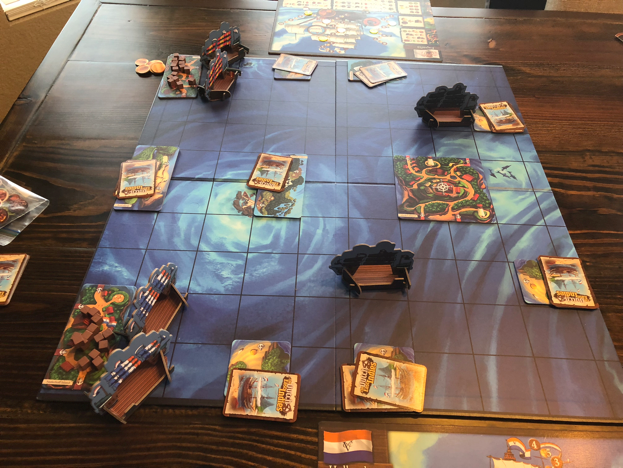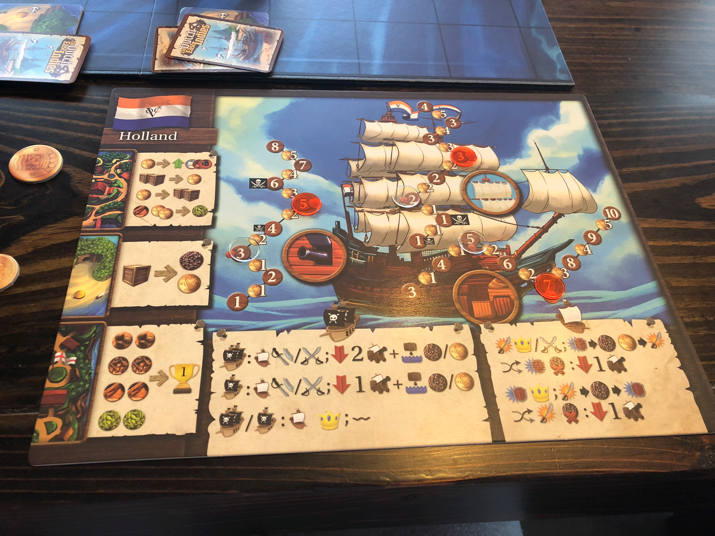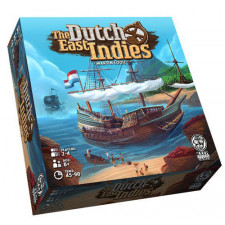The Dutch East Indies Review
on Jan 24, 2018
Critical Hits: Easy to play, Many different victory strategies for simple goal, Well thought-out game
Critical Misses: Not enough gold coins, flimsy ships
In The Dutch East Indies you must fight your fellow countries for five precious spices. Your mission may seem relatively simple, but other players and pirates seem to always get in your way of victory. Clove, Cardamom, Cinnamon, Nutmeg, and Pepper are what you are after. You may search islands such as “Vilfort Island†and “Nederhoff Island†to trade for the spices, or battle your competitors to steal theirs. Being in the 18th century, getting these spices is not so simple.
When you set the game up, the number of players changes the board size and island placements. As you would suspect, more players equals a larger board. When starting off it is recommended to start with one of their pre-determined game board placements. This will ensure equal opportunities for all players. Once you get the hang of the game, you are able to create your own setup for unlimited different game plays. The basic layout will always contain a separate home island for each player, a market island, and numerous other islands where you can trade spices.

|

|
(2 person vs. 4 person game setup)
On each players turn you must start by moving the pirate ships. These move by rolling an eight-sided die with the 4 cardinal and 4 ordinal directions on them. Each pirate moves one space in the direction of each die roll. This in theory provides continuous variability to who gets attacked and when by the pirate. However, in our games we found that one of the ships would end up getting stuck in a corner bouncing back and forth between just a few different spaces. This is just poor luck, but ultimately hinders the player whose home base is near this “stuck pirate.â€
After moving the pirates, the active player then can move their ships and complete an action (trade, battle, or ship upgrade), if able. Each of the islands contains different number of cards that have trade proposals on them. Once you port to the shown anchor of an island, you may look at the top card and decide whether you would like to do the trade. The top card is the only trade available at any point of time. The trades may give you gold or spices in exchange for crates. If you decide to do the trade, you must pay from the items in your ship and then place the newly acquired items back in there as well. The amount you may carry at any given time is shown on your player card, and will likely change throughout the game by upgrades or battle. If you decide not to do the trade, you must place the card back on top of the island without showing the other players, and is available for the next trade. This is one aspect to the game that makes things tricky. If the top card is one that no one wants, the cards below are essentially unreachable until someone’s takes the card on top. If this unwanted card is near one player’s home island it can make it can be quite unfortunate. This is due to the fact that the spices are not considered gathered until the spices travel back to the home island. For example, in our most recent game I was one spice short of winning, and my husband kept battling and stealing my spices from my ship before it could port. Not nice. This can be quite frustrating when it happens over and over again due to my inability to roll the die higher than two. We’ve all been there.
Speaking of battling, this can come from other players or the pirate. The statistics for your ship can be found on the player card marked with the plastic disks with the strength shown by the cannon. For all players, the small ship starts at a three and big ships start at a five. The big pirate will always be a six, and the little pirate a four. Individual players can trade gold coins to upgrade their stats at the market island. This is quite useful because battle plays out as your strength plus one die roll. For example if the big pirate were to attack my little ship at the beginning of the game, I would need to roll a four to win as the tie goes to the pirate.

Player card with ships strength, speed, and carrying capacity shown with the plastic discs. Red are for large ships, clear for small.
On the bottom of the player card shows the effects of battle. If you beat a pirate nothing will happen. However, if you lose to the pirate, you will lose different amounts of items, and stats based on a big or little pirate. Luckily, when you lose stats you get to choose which item to reduce based on your strategy. For example, if I must lose two stats because I lost to the big pirate, I may choose to reduce my carrying capacity down one, and my speed down one. Similarly, the bottom right section of the player card shows the effects of winning/losing to another player. You may need to give a spice and gold to the other player. One downside to this player card is that the symbols are very hard to understand without further explanation from the rulebook. The intent is great for language variability, but it is not intuitive at first.
Each player does start the game with a set amount of coins and crates that can be spent for upgrades and spices. All remaining tokens are set aside in as easy to access location used as a bank. Throughout game play resources will be added and removed from this pile as trades and upgrades are made. In a two-player game you are likely to never run out of resources. However when playing with four people, we didn’t even make it around the table once before all the gold was gone. Once it is gone, it is gone. This adds a very interesting aspect to the game in the sense of economy. You end up spending your resources much more carefully, and must have a clear strategy in mind for your game play. With limited amounts of gold available, it can be difficult to upgrade ships. When the crates run out, trading becomes nearly impossible at the surrounding islands.
One downside to the standard edition of this game is most certainly the ships. They are cardboard pieces that must be taken apart and re-put together every time you want to play. The wear and tear on them is very real, and great care must be taken to ensure they will last. We will be investing in the plastic ships that are available for purchase.

Durability of the ships is very low
Overall, this is a very fun, entertaining game to play. The rules are straight forward, and the game is a good intermediate length of time for weekday game nights. One note on the game length: the outside of the box says 30-60 minutes, and the first page of the rulebook states 45-90 minutes. For us, the four-player game took closer to two hours, and the two-player game took about an hour.
I would highly recommend this game for families or for those looking for a more simple, yet very entertaining option. Even with the large selection of games that we have, this will certainly be one that we enter into our normal rotation quite frequently. Due to the ships, I would recommend either buying the standard game with the addition of the ship upgrade, or buying the deluxe edition from the start.

 Customer Support
Customer Support  Subscribe
Subscribe 




 Account
Account  Wishlist
Wishlist 

